
Western Rogerley Quarry. Sutcliff vein workings marked in yellow. J. Gajowniczek photo.
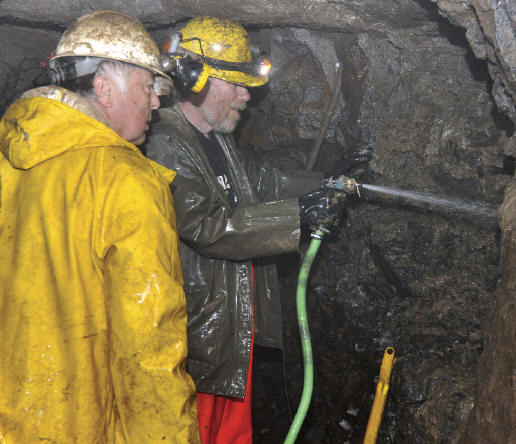
Cal Graeber (left) and Jesse Fisher (author) washing clay from one of the pockets. J. Gajowniczek photo.
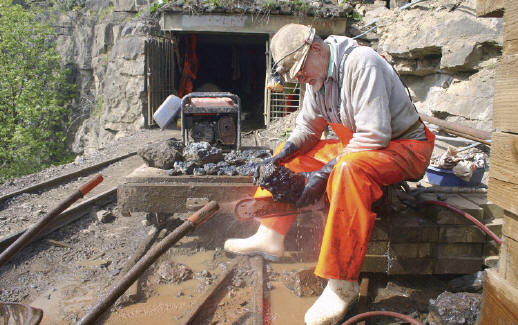
Byron(+) trimming specimens at the mine. Only a miner would sit on a diamond chainsaw to get the best angle for cutting! J. Fisher photo.
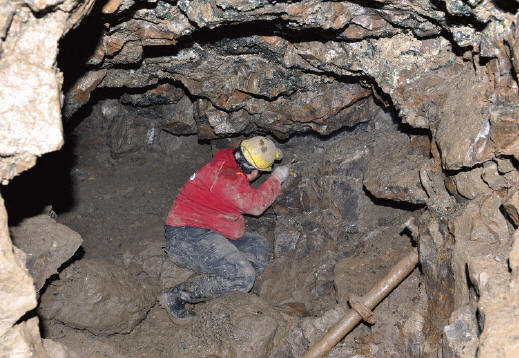
Collecting in Black Sheep Pocket in the 2010. J. Gajowniczek photo.
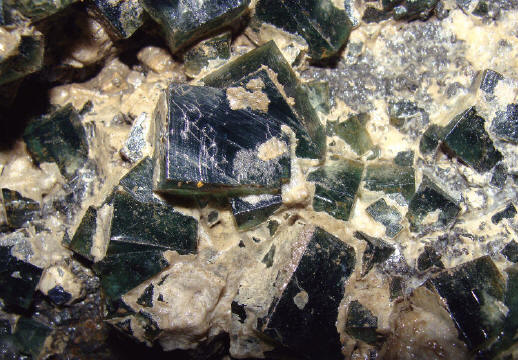
Fluorite crystals in situ in the Black Sheep Pocket. R. Brandstteter photo.
The habit of Rogerley fluorite isalways cubic, and crystals under 3 cmin size typically exhibit penetrationtwinning on [111], and are often quitetransparent. Crystals larger than 3cm are typically not twinned and aremostly opaque. Growth hillocks with fourvicinal faces are common on the cubefaces of twinned crystals and appearto emanate from the point where the twin penetrates the cube face. The mostcommon color for Rogerley fluorite is adeep emerald green, and, to date, all thefluorite found in the flats has been of thiscolor.
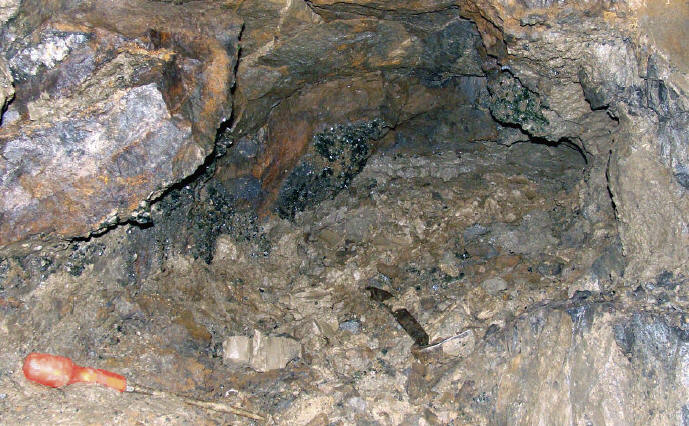
One of East Crosscut pockets. R. Brandstetter photo.
Fluorite crystals from vein pocketsare often a dark purple, though somepockets with various shades of greenand yellow have been found. Internalcolor zoning is rare though occasionalpale purple layers or core zones can beseen in crystals from the flats. Anomalous asymmetrical zones of pale yelloware sometimes seen in crystals from theflats.
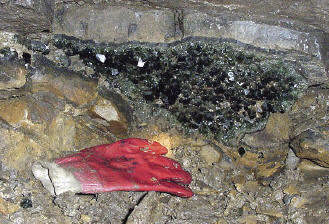
Dipper Pocket. J. Fisher photo.
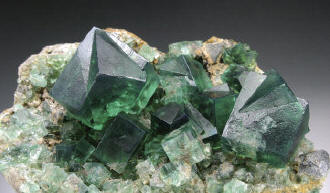
Group of fluorite crystals from Dipper pocket,field view 9 cm. UKMV specimen. J. Fisher photo.
Fluorite crystals from vein pockets(and occasionally from the flats) oftendisplay an internal cloudiness known tolocal collectors as “white centers”. Asthe name implies, these crystals arewhite and opaque in the center whilehaving gemmy transparent edges andcorners. It is not unusual to find specimenswhere one or several larger transparentfluorite crystals are surroundedby numerous smaller crystals, all withwhite centers. This internal cloudinessappears to be caused by numerous microscopicvoid spaces within the crystal,but it is unclear whether these are agrowth feature or the result of a partialdissolution or etching of the fluorite.
Fluorite from the Rogerley (as wellas most other mines in the North Pennines)exhibits a notable color changebetween artificial and daylight illumination,an effect known as daylight fluorescence.
Both purple and green fluoriteshow pronounced blue overtones in director even indirect sunlight. This effectis likely caused by the ultra-violet (UV) component of the daylight spectrum,which is largely absent in artificial light.
The UV fluorescence of North Penninesfluorite is also exceptionally strong, particularlyunder long-wave UV. It is saidthat studies of this material by SirGeorge Stokes in 1852 were the originalsource of the term fluorescence. It hasbeen known for some time that fluoritefrom this region contains elevated levelsof a number of rare-earth (Lanthanideseries)elements and it is likely that thisis the cause of the intense UV and daylightfluorescence.
HISTORY OF THE ROGERLEY MINECumbria Miningand Mineral CompanyThe Cumbria Mining and MineralCompany (CMaMC) was formed in 1972by Lindsay and Patricia Greenbank, andMichael and Brenda Sutcliffe with the intentionof mining mineral specimens on acommercial basis. The concept of operatinga mine solely for specimens wasquite novel in the UK at the time and wasnot taken seriously by governmentalmineral agents. After unsuccessful attemptsto obtain leases on properties inboth Caldbeck Fells and Alston Moor, thepartnership obtained permission to explorethe previously unworked fluoritebearingveins in the Rogerley Quarry.
Fluorite specimens were originallydiscovered along the base of the quarrywall around 1970 by mineral collectorRaymond Blackburn. He determinedthat the source of the specimens was aspot high up on the north face of thequarry, but, being somewhat adverse tohigh places, he did not attempt to collectat the actual source. Lindsay Greenbank,a well-known collector and dealerfrom Cumbria, was aware of the occurrence,having purchased specimens fromMr. Blackburn. As he did not share Mr.
Blackburn’s aversion to high places, heand partner Mick Sutcliffe began investigatingthe occurrence by roping downfrom the top of the quarry. The source ofthe fluorite specimens was found to becavities in both a N-S trending vein exposedon the quarry wall and the flatsextending latterly from it. This vein issplit into two stringers separated byabout one meter as exposed on thequarry face, and has been named theGreenbank vein by Sir Kingsley Dunham,a noted authority on the geology andmineralogy of the region.

One of West Crosscut pockets photographed in May 2004. J. Fisher photo.
Leases for mineral rights were obtainedfrom the mineral agents for theChurch Commissioners of England; trespassrights were arranged with the locallandowner, and the mine was operatedon weekends for specimens over thecourse of the next 25 years. Work initiallyfocused on cavities that occur in the High Flats Horizon near the top ofthe Great Limestone, the rock unit thatsupports the walls of the quarry. Duringthe early to mid 1970’s a bench around10 meters long was cut into the face approximately20 meters above the floor ofthe quarry, and three fluorite-producingzones were encountered.
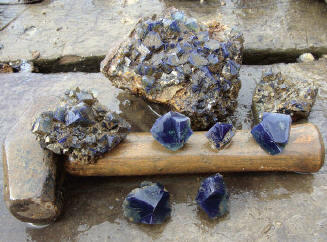
Freshly collected specimens from East Crosscut. R. Brandstetter photo.
A second vein, named the Sutcliffevein (54°44’27.06”N, 1°59’16.07”W), wasdiscovered on the face of a western extensionof the quarry 500 meters northwestof the Greenbank vein. A limitedamount of surface work was done on theSutcliffe vein during the mid 1970’s andsome good quality specimens of green and purple fluorite were found. Access tothis outcrop was difficult to control, andhigh graders were a constant problem sowork was soon shifted back to the originallocation.












 YueGongAnBei 44051102000467
YueGongAnBei 44051102000467


 |
|